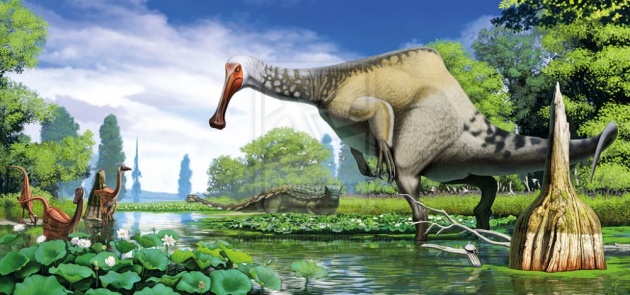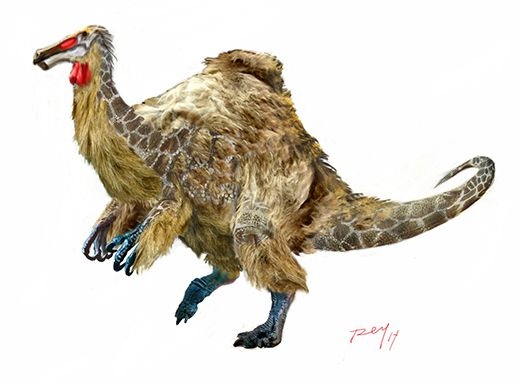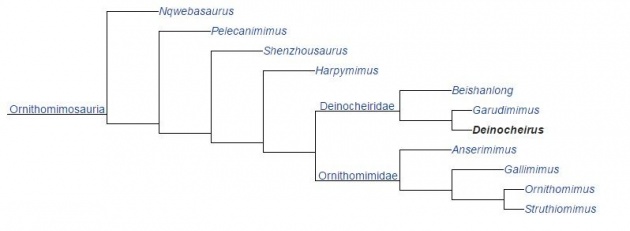
The remains of the first known fossil is a pair of large front arm and the remains of some ribs and spine. They were found on July 9, 1965 during the Polish-Mongolian expedition to the Gobi by Professor Zofia Kielan-Jaworowska at Altan Ula III sites in Ömnögovi Province. Kielan-Jaworowska published the find in 1966.
Deinocheirus called by Halszka Osmólska and Ewa Roniewicz in 1970. The species and species just named is Deinocheirus mirificus. The generic name is derived from the Greek deinos (δεινός), meaning "terrible", and cheir (χείρ), which means "hand". The specific name, mirificus, derived from the Latin, meaning "unusual" or "strange," and selected for "the unusual structure of the forelimbs.

The highest known theropods, higher than contemporary predators such Tarbosaurus.Though Deinocheirus arm has a fairly large absolute size, becoming the longest of any known theropod Therizinosaurus exceptions, they are not very long relative to the shoulder girdle, the ratio becomes less than that with most ornithomimosaurs . Shoulder-blade long and narrow. Humerus is relatively slim. The ulna and radius are also being elongated and not too firmly connected to each other in a syndesmosis. Metacarpus is long compared to the radius. Hand has good mobility relative to the forearm but only able to deflect the movement is limited, can not close the catch. The fingers are about equal in length to each other, the first being the fattest and the second longest. Only the left claw of the second toe has been preserved as a whole; it has a diameter of 196 millimeters and a length along the outer arch of 323 millimeters.
Reports of new specimens, when they were formally undescribed, indicating that the animal has a hump on his back and skull superficially resembles a cross between ornithomimosaur and hadrosaur.In 2014, a new reconstruction based on two nearly complete specimens published in Nature.It show bipedal, relatively upright animal-walking, sports back in high neural spines up to 8.5 times the height of the centrum, almost reaching the highest ratio seen in Spinosaurus

Prior to the issuance of a new reconstruction based on the remains of a nearly complete skeleton in 2014 which confirmed that indeed ornithomimosaur Deinocheirus large, scientists do not always agree about the placement Deinocheirus within Dinosauria. While initially assigned Kielan-Jaworowska find to Megalosauridae, Osmólska and Roniewicz create a new family for Deinocheirus, which Deinocheiridae. Family Deinocheiridae initially placed in the infraorder Carnosauria, thanks to the "gigantic size and thick walled limb bones" but Osmólska and Roniewicz also speculated that it might be "a relationship between Carnosauria and coelurosaurs". In Carnosauria, Deinocheiridae family was hesitant, "faute de mieux", assigned to the superfamily Megalosauroidea, basically because it's clearly not tyrannosauroid, which have greatly reduced forelimbs endowed with only two very small finger.
Peter Makovicky et al. show that if Deinocheirus is ornithomimosaur, it is one that is quite primitive, because it does not have some features that are typically seen in the characteristics ornithomimosaurs.Basal including crooked claws, the ratios of the humerus / scapula is low, the lack of syndesmosis, short posterior coracoid process and the combined length second phalanx of the third finger and a third larger than the length of the third phalanx. Yoshitsugu Kobayashi and Rinchen Barsbold add Deinocheirus to several recent cladistic analyzes of theropods and was unable to complete the proper relationship, but noted some support for it as ornithomimosaur possible. The characteristics are derived includes short-handed, a Metacarpus relatively flat and extended claws.
Under the following cladogram analysis by Yuong-Nam Lee, Rinchen Barsbold, Philip J. Currie, Yoshitsugu Kobayashi, Hang-Jae Lee, Pascal Godefroit, François Escuillié & Tsogtbaatar Chinzorig (2014).




